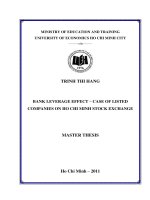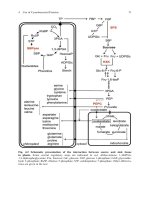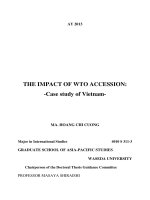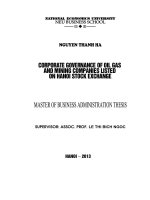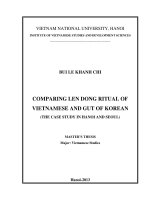Determinats of dividend policy case study listed companies on hochiminh stock exchange
Bạn đang xem bản rút gọn của tài liệu. Xem và tải ngay bản đầy đủ của tài liệu tại đây (1023.99 KB, 96 trang )
MINISTRY OF EDUCATION AND TRAINING
UNIVERSITY OF ECONOMICS HOCHIMINH CITY
----------o0o---------
KHƯU CẨM TÚ
DETERMINANTS OF DIVIDEND POLICY
CASE STUDY: LISTED COMPANIES ON
HOCHIMINH STOCK EXCHANGE
MASTER THESIS
Ho Chi Minh City - 2011
MINISTRY OF EDUCATION AND TRAINING
UNIVERSITY OF ECONOMICS HOCHIMINH CITY
----------o0o---------
KHƯU CẨM TÚ
DETERMINANTS OF DIVIDEND POLICY
CASE STUDY: LISTED COMPANIES ON
HOCHIMINH STOCK EXCHANGE
MAJOR: BANKING AND FINANCE
MAJOR CODE : 60.31.12
MASTER THESIS
INSTRUCTOR : DOCTOR TRẦN PHƯƠNG NGỌC THẢO
Ho Chi Minh City - 2011
ACKNOWLEDGEMENT
First and foremost I would like to thank my supervisor, Doctor Tran Phuong
Ngoc Thao for her guidance and support.
In addition I would also like to express my gratitude to Doctor Vo Xuan Vinh
for his valuable feedback on the problems of the study.
Special thanks also go to all of my lecturers at Banking and Finance Faculty,
University of Economics Hochiminh City for their teaching and guidance during
my Master of Banking and Finance course.
I also wish to thank my friends in Dong A Securities, Au Viet Securities,
Thang Long Securities and China Trust Bank for their great support.
Finally, my greatest thanks would go to my family including my parents, my
husband and my baby who are the greatest encouragement for me to overcome all
difficulties in my life.
i
ABSTRACT
This thesis aims to add empirical evidence to the corporate finance literature by
looking at firms’ dividend policy in the context of Hochiminh Stock Exchange
(HOSE) of Vietnam as an emerging market.
The thesis consists of five chapters. After an introductory chapter, the study
reviews the existing literature on the dividend policy controversy with an emphasis
on the recent empirical works. The following third chapter provides the research
methodology for the study. The study applies panel data procedures, random effects
logistic regression, random effects generalized least square (GLS) regression and
multinomial logistic regression to estimate and test the determinants of dividend
policy of l09 firms listed on HOSE. While the main findings of this study which are
consistent with theory are reported in the fourth chapter, there are new major
insights that represent the special case of emerging markets in general and Vietnam
in particular. These main insights, as well as the main conclusions of the study, are
summarized in Chapter 5, including some limitations and recommendations for
future research.
Our findings is that many of the factors that are found to be significant in the
determination of dividend policy of the firms listed on HOSE are the same as those
found in developed capital markets such as profitability, firm size and tangibility.
Besides, we find that the listed firms on HOSE fail to pay dividend only because of
making loss or too small profit in business operation, not because of having
investment opportunities in the future. We also find some evidence to support the
life cycle theory. Our findings suggest that firms with greater investment, as
measured by growth rate of sales are more likely to prefer paying stock dividends to
cash dividends.
Keywords: Dividend policy, Vietnam, HOSE.
ii
CONTENTS
Acknowledgement ................................................................................................ i
Abstract................................................................................................................ii
Contents ............................................................................................................. iii
List of Figures ..................................................................................................... vi
List of Tables ..................................................................................................... vii
Abbreviations...................................................................................................... ix
CHAPTER 1: INTRODUCTION
1.1. Introduction ..................................................................................................... 1
1.2. The usefulness of the research .......................................................................... 2
1.3. Research objectives .......................................................................................... 2
1.4. Research methodology...................................................................................... 3
1.5 The structure of the research ............................................................................. 4
CHAPTER 2: LITERATURE REVIEW
2.1. Introduction ...................................................................................................... 6
2.2. Dividend theories and concerned empirical studies ........................................... 6
2.3. Empirical studies on the determinants of dividend policy ................................. 8
2.3.1. Profitability ............................................................................................. 8
2.3.2. Firm size ................................................................................................. 9
2.3.3. Financial leverage .................................................................................10
2.3.4. Growth opportunities.............................................................................10
2.3.5. Asset tangibility ....................................................................................11
iii
2.3.6. Business risk .........................................................................................11
2.4. Conclusion......................................................................................................12
CHAPTER 3: RESEARCH METHODOLOGY
3.1. Introduction ....................................................................................................13
3.2. Data specifications..........................................................................................13
3.2.1 Research sample description...................................................................13
3.2.2. Explanatory variables ............................................................................15
3.2.2.1 Variables those vary both across firms and time..........................15
3.2.2.1.1 Return on assets (ROA)...............................................15
3.2.2.1.2 Firm size .....................................................................16
3.2.2.1.3 Financial leverage .......................................................16
3.2.2.1.4 Growth opportunities ..................................................17
3.2.2.1.5 Asset tangibility ..........................................................17
3.2.2.2 Variables that vary only across firms ..........................................18
3.2.2.2.1 Business risk (Beta) ....................................................18
3.2.2.2.2 Industry dummies........................................................18
3.2.3 Dependent variables – Dividend policy ..................................................18
3.3. Empirical model specifications .......................................................................19
3.3.1 Model 1 ..................................................................................................19
3.3.2 Model 2 ..................................................................................................20
3.3.3 Model 3 ..................................................................................................21
iv
CHAPTER 4: DATA ANALYSIS AND FINDINGS
4.1 Introduction .....................................................................................................23
4.2 Descriptive statistics ........................................................................................23
4.3 Correlation matrix of explanatory variables .....................................................26
4.4 Results of Model 1...........................................................................................27
4.5 Results of Model 2...........................................................................................30
4.6 Results of Model 3...........................................................................................34
4.7 Robustness tests...............................................................................................38
CHAPTER 5: CONCLUSION
5.1 Introduction .....................................................................................................41
5.2 Conclusion.......................................................................................................41
5.3 The implications of the research ......................................................................42
5.4 Limitations and recommendations for future research ......................................44
References ............................................................................................................46
Appendix A – Regression results of 3 models.......................................................51
Appendix B – List of 109 non-financial firms, classified industries and beta ........58
Appendix C – The Dividend Time Lines of 109 firms on HOSE 2007-2009 ........62
Appendix D – Explanatory Variables calculated from Financial Statements .........74
v
LIST OF FIGURES
Figure 1.1. Research methodology.......................................................................... 4
Figure 1.2. The structure of the research ................................................................. 5
Figure 3.1. Outline of chapter 3 ...........................................................................13
Figure 3.2. Summary of research data collection...................................................15
vi
LIST OF TABLES
Table 4.1. Summary of the industry structure........................................................24
Table 4.2. Summary of the dividend policy of 109 firms listed on HOSE .............24
Table 4.3. Summary of the dividend forms of payers listed on HOSE ...................25
Table 4.4. Descriptive statistics of the explanatory variables.................................26
Table 4.5. Variance inflation factor (VIF) for the explanatory variables................27
Table 4.6. Correlation coefficients among the explanatory variables .....................27
Table 4.7. The reported results of Model 1 ............................................................28
Table 4.8. Descriptive statistic of ROA of dividend non-payers and payers ..........29
Table 4.9. The reported results of Model 2 ............................................................30
Table 4.10. Summary of current debts/total debts ratio .........................................33
Table 4.11. Summary of cash dividend per share of firms in the different classified
industries ...............................................................................................................34
Table 4.12. The reported results of Model 3 ..........................................................35
Table 4.13. Summary of revenues growth of cash dividend payers and stock
dividend payers .....................................................................................................36
Table 4.14. Summary of dividend forms of firms in Basis Material sector ............37
Table 4.15. Summary of dividend forms of firms in Consumer Staples sector.......38
Table 4.16. Summary of dividend forms of firms in Consumer Discretionary sector
..............................................................................................................................38
vii
Table 4.17. Results of Model 1: Fixed Effects versus Random Effects ..................39
Table 4.18. Results of Model 2: Fixed Effects versus Random Effects ..................39
viii
ABBREVIATIONS
HOSE
Hochiminh Stock Exchange
DPS
Dividend per share
EPS
Earning per share
ROA
Return on assets
SIZE
Firm size
DEBT
Financial leverage
TANG
Asset tangibility
GROW
Growth rate of revenues
LOGIT
Logistic regression
GLS
Generalized least square regression
VND
Vietnam Dong
ix
Determinants of Dividend Policy
CHAPTER 1 : INTRODUCTION
1.1.
INTRODUCTION
Problems concerning dividend policy have puzzled both academics and
corporate managers for several decades. Dividend may enhance the market value of
the company but on the other hand it may mean less of available internal funds and
more dependence on external sources for expansion purposes. Furthermore, while
determining dividend payment, a prudent management strikes a balance between
shareholder’s expectation and firm’s long term interest. A deeper understanding as
to the motivation behind dividends will provide opportunity to better value stock, as
most current stock valuation models include dividends as a key element. Besides, it
might held the policy makers to find the loop holes and to craft a better policy for
future.
Dividend policy decision is affected by many factors. These factors may vary
substantially from country to country. Most of the studies on determinants of
corporate dividend policy have been conducted using data from developed
countries. To date, to the author’s knowledge, no quantitative study has been
conducted using data from Hochiminh Stock Exchange (HOSE) of Vietnam and
corollary of insufficient information for academics, policy makers and investors on
Vietnam stock market. This has inspired the author to conduct this study , which is
expected to guide the dividend policy of Vietnamese companies.
The remainder of this chapter provides general introduction about the
usefulness of the research, the research objectives, research methodology and the
structure of the research
1
Determinants of Dividend Policy
1.2.
THE USEFULNESS OF THE RESEARCH
Firstly, this study provides insights and guidance for investors in choosing the
kind of stocks having dividend payment level and dividend form suitable to their
preference (details presented in chapter 4).
Secondly, this study provides a useful caution that investors should not be
fooled when the firms say “we do not pay dividend because we have investment
opportunities”. In fact, the listed firms on HOSE fail to pay dividend only because
of making loss or too small profit in their business operation, not because of having
investment opportunities in the future. In other words, the probability of paying
dividend of firms listed on HOSE totally depends on their business profit.
Finally, we also provide academics with empirical evidence on determinants of
dividend policy of Vietnam stock market. Our findings is that many of the factors
significant in the determination of dividend policy of the firms listed on HOSE are
the same as those found in developed capital markets such as profitability, firm size
and asset tangibility. We also find some evidence to support the life cycle theory.
Our findings suggest that firms with greater investment, as measured by growth rate
of sales are more likely to prefer paying stock dividends to cash dividends. On the
other hand, mix of both cash and stock dividend payers are associated with bigger
firm size than cash dividend payers.
1.3.
RESEARCH OBJECTIVES
The research is planned in the context of firms listed on Hochiminh Stock
Exchange (HOSE) of Vietnam. The main purpose of this paper is to investigate the
dividend policies of the non-financial firms listed on HOSE for the period of 20072009, and to explain their dividend payment behavior.
Research questions are specified to solve research objectives as follows :
2
Determinants of Dividend Policy
Q1: What factors determine the probability of paying dividend of firms listed on
HOSE? What reasons make the firms not pay dividends?
Q2: What factors determine cash dividend per share of firms listed on HOSE?
Q3: What factors determine the probability of choosing the different forms of
dividend payment (stock dividend, or cash dividend or mix of cash and stock
dividend)?
Q4: Do firms in different classified industries have different dividend policies?
1.4.
RESEARCH METHODOLOGY
The paper uses a firm-level panel data set of 109 publicly traded non-financial
firms on Hochiminh Stock Exchange between 2007 and 2009.
The empirical steps to examine the above mentioned research objectives
proceed as follows :
Descriptive statistics
Correlation matrix
Using random effects logistic regression model to test the determinants of
the probability of paying dividend
Using random effects generalized least square (GLS) regression model to test
the determinants of cash dividend per share of firms listed on HOSE
Using multinomial logistic regression to test the determinants of the
probability of choosing the different forms of dividend payment (stock
dividend, or cash dividend or mix of cash and stock dividend)
Stata software version 11 is used as an data analysis tool to implement this
research.
3
Determinants of Dividend Policy
Figure 1.1. Methodology
Literature review
Theory/hypothesis/model
Data collection
Estimation and testing
No
Are results
consistent
with theory?
Yes
Conclusion
and feedback
1.5.
THE STRUCTURE OF THE RESEARCH
The organization of the paper is as follows. The next section reviews some
important previous studies abroad. The third section describes the data and
methodology. The fourth section presents the results and the last section contains
the main conclusions of the study.
The structure of the research is summarized in figure 1.2 as follows :
4
Determinants of Dividend Policy
Figure 1.2. Structure of the study
Chapter 1
Introduction
Chapter 2
Literature Review
Chapter 3
Research Methodology
Chapter 4
Data Analysis and Findings
Chapter 5
Conclusion
5
Determinants of Dividend Policy
CHAPTER 2 : LITERATURE REVIEW
2.1. INTRODUCTION
This chapter reviews relevant theories and models of dividend problem in the
literature. The purpose of this review is to provide the background for the research
hypotheses as well as the research models which will help to test our mentioned
research objectives in Vietnam stock market as an emerging market.
2.2. DIVIDEND THEORIES AND CONCERNED EMPIRICAL STUDIES
The bird-in-hand theory, a pre-Miller-Modigliani theory, postulates that
investors prefer dividends from a stock to potential capital gains because of the
inherent uncertainty of the latter. In other words, investors prefer the certainty of
dividend payments to the possibility of substantially higher future capital gains.
Therefore, a high payout ratio will reduce the required rate of return (cost of
capital), and hence increase the value of firm (Gordon, 1959).
However, Miller and Modigliani (1961) demonstrate that under certain
assumptions such as rational investors and a perfect capital market, the market
value of firm is independent of its dividend policy. In actual market practices,
nonetheless, these assumptions do not hold and dividend policy does seem to
matter. Over the years, dozens of theories have attempted to explain the dividends
phenomenon without reaching any consensus . Many of the theories regard
dividends as a signaling device to mitigate information asymmetry problems.
Others view agents as rational and dividends either serve as an efficient way to
resolve agency problems, or to reduce transaction costs to shareholder in managing
their funds.
According to signaling models (Bhattacharya, 1979; John and Williams, 1985;
and Miller and Rock, 1985) dividends contain the information about the current or
future level of earnings and therefore can be used as a signaling device to influence
the share price. Only good-quality firms can send signals to the market through
6
Determinants of Dividend Policy
dividends and poor-quality firms cannot mimic these because of the dissipative
signaling costs (for example, transaction costs of external financing, tax penalties
on dividends, or distortion of investment decisions). An announcement of dividend
increase is considered as good news and accordingly the share price reacts
favorably, and vice versa. Support for the signaling hypothesis can be found, for
example, in Nissim and Ziv (2001), and Bali (2003).
A different explanation for dividend policy is based on the agency cost (La
Porta et al., 2000). The agency cost theory predicts that dividend payments can
reduce the problems associated with separation of ownership and management
control. Dividends serve as a mechanism to reduce free cash flow under
management control, and thus help to mitigate the agency problems. Reducing
funds under management discretion may result in forcing them into the capital
markets more frequently, thus putting them under the scrutiny of capital suppliers
(Rozeff,1982). Many researchers have offered empirical support for the agencytheory explanations of why firms pay dividends such as Holder et al. (1998), among
others. They document that the firms with higher levels of free cash flow have
higher agency costs and need higher dividend payout ratios to reduce those agency
costs. Others including Yoon and Starks (1995), and Lie (2000) provide little
support or reject the hypothesis.
Another explanation relates dividend policy to the transaction costs. Due to
paying dividends, the firm has to raise external financing in order to meet
investment needs. Transaction cost include flotation costs to the firm of raising
additional external finance such as underwriter fees, administration costs,
management time and legal expenses. This theory indicates that firms incurring
large transaction costs, will be required to reduce dividend payouts to avoid the
costs of external financing (Alli et al.,1993; Holder et al., 1998).
Another vein of the literature ties dividend payout to firms’ life cycle. In
particular, numerous papers observe that firms that pay dividends tend to be more
7
Determinants of Dividend Policy
mature and less volatile. According to Grullon et al. (2002), firms that exhaust their
investment opportunities increase their dividends, and thus dividends indicate firm
maturity rather than signaling future profitability. Several papers highlight the link
between dividends and idiosyncratic risk. Fink, Fink, Grullon, and Weston (2004)
document that dividend-paying firms have lower idiosyncratic volatility. Bradley,
Capozza, and Seguin (1998) and Chay and Suh (2008) explain the link between
dividends and volatility in selection : Only firms with low cash-flow uncertainty
feel comfortable with committing to paying dividends, an attitude consistent with
the conservative managerial views in Lintner (1956) and Brav et al. (2005). Hoberg
and Prabhaha (2009) determine that the disappearance of dividends (Fama and
French, 2001) is associated with an increase in idiosyncratic risk. Supporting the
view that the decline in idiosyncratic risk is related to firm maturity, studies find
that idiosyncratic is negatively correlated with the firm governance index ( Ferreira
and Laux, 2007) and firm age ( Fink et al., 2004). DeAngelo, DeAngelo, and Stulz
(2006) also find supporting evidence for the life-cycle theory : Firms are more
likely to pay out dividends when their equity is earned through operations, rather
than contributed by investors.
2.3. EMPIRICAL STUDIES ON THE DETERMINANTS OF DIVIDEND
POLICY
This section reviews empirical studies concerning the effects of individual
variables on dividend policy. These empirical studies will provide background for
the author to collect research data and to establish the research hypothesis and
methodology. The considered individual variables include profitability, firm size,
financial leverage, growth opportunities, assets tangibility and business risk
2.3.1. Profitability
The financial literature documents that a firm’s profitability is a significant and
positive explanatory variable of dividend policy (Jensen et al., 1992; Han et al.,
1999; Fama and French, 2001; Al-Malkawi, 2007). However, there is a significant
8
Determinants of Dividend Policy
difference between dividend policies in developed and developing countries. Wang
et al. (2002) compare the dividend policy of Chinese and UK listed companies, and
find that the former tends to vote for a higher dividend payout ratio, than the latter.
Moreover, UK companies have a clear dividend policy in which annual dividend
increases and most of companies pay a cash dividend. In contrast, Chinese
companies have unstable dividend payments and their dividend ratios are heavily
based on firm earnings in the same year, not on any other factor. The latter finding
is consistent with that of Adaoglu (2000), who states that the main determinant in
the amount of cash dividends in the Istabul Stock Exchange is earnings for the same
year.
2.3.2. Firm size
Jensen et al. (1992) and Redding(1997) indicate that large firms distribute a
higher amount of their net profits as cash dividends, than small firms do. Other
studies relate the positive association between dividends and firm size to transaction
costs. For example, Holder et al. (1998) reveal that larger firms have better access
to capital markets and find it easier to raise funds at lower costs, allowing them to
pay higher dividends to shareholders. This demonstrates a positive association
between dividend payouts and firm size. Furthermore, Sawicki (2005) illustrates
that dividend payouts can help to indirectly monitor the performance of managers in
large firms. That is, in large firms, information asymmetry increases due to
ownership dispersion, decreasing the shareholder’s ability to monitor the internal
and external activities of the firm, resulting in the inefficient control by
management. Paying large dividends can be a solution for such a problem because
large dividends lead to an increase in the need for external financing, and the need
for external financing leads to an increase in the monitoring of large firms, because
of the existence of creditors.
Several studies have tested the impact of firm size on the dividend-agency
relationship. Lloyd et al. (1985) are among the first to modify Rozeff’s model by
9
Determinants of Dividend Policy
adding ‘firm size’ as an additional variable. They find it as an important explanatory
variable, as large companies are more likely to increase their dividend payouts to
decrease agency costs.
2.3.3. Financial leverage
A growing number of studies have found that the level of financial leverage
negatively affects dividend policy (Gugler and Yurtoglu, 2003; Al-Malkawi, 2007).
Their studies infer that highly levered firms look forward to maintaining their
internal cash flow to fulfill duties, instead of distributing available cash to
shareholders and protect their creditors.
Furthermore, Mollah et al. (2001) examine an emerging market and find a
direct relationship between financial leverage and debt-burden level that increases
transaction costs. Thus, firms with high leverage ratios have high transaction costs
in raising external finance, and therefore are in a weak position to pay high
dividends
2.3.4. Growth Opportunities
A number of studies (Moh’d et al., 1995; Holder et al., 1998) reveal that
dividends are found to be higher in firms with slow growth opportunities, compared
to firms with high-growth opportunities. Since external financing is costly, fastgrowing companies require internally generated funds to finance their investment
projects, thereby reducing dividends. In contrast, companies with slow growth and
fewer investment opportunities have a greater ability to pay higher dividends.
Moreover, La Porta et al. (2000) investigate countries with high legal protection
and reveal that fast-growth firms pay lower dividends, as the shareholders are
legally protected, allowing them to wait to receive their dividends when the
investment opportunities are good. On the other hand, in countries with low legal
protection for shareholders, firms keep the dividend payout high, to develop and
maintain a strong reputation, even when they have better investment opportunities.
10
Determinants of Dividend Policy
2.3.5. Assets Tangibility
The previous literature assumes that there is a relationship between the firm’s
assets structure and firm dividend policy. “Firm with more tangible assets have
greater tax benefits without relying on debt, and therefore might be more inclined to
use dividend policy to influence information asymmetry and agency costs” (Koch
and Shenoy, 1999). On the contrary, it is argued that asset tangibility has an inverse
relationship with dividend policy, especially in developing markets. Aivazian et
al.(2003) state “when the assets are more tangible, fewer short-term assets are
available for bank to lend against. This imposes financial constrains on firm
operating in more primitive financial systems, where, the main source of debt is
short-term bank financing”.
2.3.6. Business risk
It has been argued that high-risk firms tend to have a higher volatility in their
cash flows, than low-risk firms. Consequently, the external financing requirement
of such firms will increase, driving them to reduce the dividend payout to avoid
costly external financing (Chen and Steiner, 1999). Jensen et al. (1992) contend that
greater systematic risk increased the uncertainty of the direct relationship between
current and expected future profits. Hence, firms avoid commitment to pay large
dividends, as the uncertainty about earnings increases. Moh’d et al. (1995) also
report an inverse relationship between the dividend ratio and intrinsic business risk,
proxied by the share’s beta. They indicate that firms with unstable earnings pay
lower dividends, in an attempt to keep the dividend payout stable and to avoid the
high cost of external financing. In contrast, Mollah (2001) finds that firms listed on
the Dhaka Stock Exchange pay a large dividend, even though the beta for their
stock is high. He then argues that in an emerging stock exchange, dividend may not
be the most appropriate tool to convey correct information about transaction costs to
the market.
11
Determinants of Dividend Policy
2.4. CONCLUSION
Dividend policy in emerging markets is often different in its nature,
characteristics, and efficiency, from that of developed markets. The above review of
the literature reveals several different explanations for the factors which effect on
dividend policy. These factors vary substantially from country to country. That is
one of the reasons why we want a study for Vietnam stock market because we do
not know yet which theory applies to Vietnam firms and which empirical studies is
consistent with Vietnam stock market.
12
Determinants of Dividend Policy
CHAPTER 3 : METHODOLOGY
3.1. INTRODUCTION
This chapter provides the details of research data collection and applied
research hypothesis and methodology to test research objectives. The outline of this
chapter is summarized in figure 3.1 as follows :
Figure 3.1. Outline of chapter 3
3.1
.
Introduction
Research Sample
Description
3.2
Data Specifications
Explanatory Variables
and Hypothesis
3.3
..
Empirical Model Specifications
3.2. DATA SPECIFICATIONS
3.2.1. RESEARCH SAMPLE DESCRIPTION
For the study, the sample of 109 firms of Hochiminh Stock Exchange has been
taken into the consideration. We select 109 firms based on the following criteria :
1. Listed on Hochiminh Stock Exchange during the period 2007-2009
2. Be non-financial firms. In other words, funds, securities companies, banks
and other financial firms are excluded from the sample. Following previous
research (Fama and French (2001), DeAngelo et al. (2006)), we exclude
financial firms because these firms operate in a highly regulated
environment.
3. Must have non-missing values on dividends and the financial database
13
Determinants of Dividend Policy
4. Trading sections of the firms are not be interrupted because of their
violation of the regulations of Hochiminh Stock Exchange.
The present study includes both dividend-paying as well as non-dividendpaying firms. Because if value-maximizing firms choose not to pay dividends, a
sample that contains only dividend paying firms will be subject to a selection bias .
Kim and Maddala (1992) demonstrate that it is important to allow for zero
observations on dividends in the estimation of models of dividend behavior.
Likewise, Deshmukh (2003) states “ If firms find it optimal to not pay dividends,
then their exclusion from any empirical analysis may create a selection bias in the
sample, resulting in biased and inconsistent estimates of the underlying parmeters”.
The data has been collected from the web of Hochiminh Stock Exchange for the
period 2007 to 2009, specified as follows :
The explanatory variables of the study including return on assets (ROA),
firm size, financial leverage, asset tangibility, growth opportunities have
been calculated from the Audited Annual Financial Statements of 109 firms
for the period of 2006 to 2009.
The last explanatory variable – business risk (beta) has been calculated from
history of adjusted stock price of these 109 firms and history of VNindex.
The dependent variable – dividend per share has been collected from the
dividend time line of 109 firms for the period 2007 to 2009. For firms paying
more than once per year, we add all times of the dividend payment to
calculate dividend per share for the whole year. (see more in Appendix B)
The classification of industries has been adjusted with reference of the
“Market Review” report of Vietnam International Securities Company.
( /> Panel structure is by year.
14

